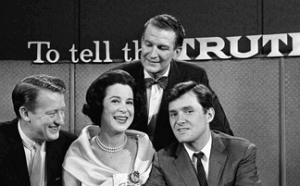|
Today in New Orleans History |
|
|
September 3


 To receive an update for each day in New Orleans history,
join our facebook page - Today in New
Orleans History.
 To receive an update for each day in New Orleans
history, join our facebook page
- Today in New Orleans History
Woolco, a full-line discount department store company, was
founded in 1962 in Columbus, Ohio by the F.W. Woolworth Company. The first Woolco store was located in Columbus. By 1966, there were 18 in the United States and nine in Canada with corporate plans to open 30 more stores
per year. By the mid-1970s, over 300 Woolco stores were in business across North America. Many locations contained
Red Grille restaurants selling popcorn, milkshakes, and other fast-food items. The
American stores were closed in 1982. The remaining Canadian stores were sold to rival Walmart in 1994. This advertisement for the Westbank location ran in the September 3, 1966
edition of the Times-Picayune.
Sarah Laumann was attacked on the night of September 3, 1919. Neighbors came to check on the young woman, who had lived alone, and broke into the home when Laumann did not answer. They discovered the 19 year-old lying unconscious on her bed, suffering from a severe head injury and missing several teeth. The intruder had entered the apartment through an open window, and attacked the woman with a blunt object. A bloody axe was discovered on the front lawn of the building. Laumann recovered from her injuries, yet couldn't recall any details from the attack. Police arrested several suspects but all were cleared of charges. See aso October 27. In the early 1950s, Carlisle was an occasional panelist on the NBC game show, Who Said That?, She
was a panelist on To Tell the Truth from 1956 to 1978. She was also a semi-regular panelist on Password, Match Game,
Missing Links, and What's My Line? On December 31, 1966, Carlisle made her debut with the Metropolitan Opera as
Prince Orlofsky in Strauss's Die Fledermaus and made her final performance with the company was on July 7, 1973 Carlisle
resumed her film career in 1987 in Woody Allen's Radio Days . She also appeared in 1993's Six Degrees of Separation.
Her last movie appearance was in Catch Me If You Can (2002) in which she played herself in a dramatization of a 1970s To Tell
the Truth episode. Known for her gracious manners and personal elegance Catherine Conn was honored by her New Orleans
school, Louise S. McGehee, as a Distinquished Alumnaein 1994. She was a long-time spokeswoman for the arts. served 20 years
on the New York State Council on the Arts. In 1991, and received the National Medal of Arts from President George H. W. Bush.
She passed away on April 17, 2007. Born in New Orleans on May 27, 1900, Jazzman Albert Nicholas's primary instrument was the clarinet, which
he studied with Lorenzo Tio in his hometown of New Orleans. Late in the 1910s he played with Buddy Petit, King Oliver, and
Manuel Perez. He spent three years in the Merchant Marines and then joined up again with Oliver in Chicago from 1925 to 1927.
After time in East Asia and Egypt, he returned to New York City in 1928 and played with Luis Russell until 1933, playing there
with Red Allen, Charlie Holmes, and J. C. Higginbotham. Later he played with Chick Webb, Louis Armstrong (with Russell) and
Jelly Roll Morton (recorded 1929, 1939). He died on September 3, 1973 in Basel, Switzerland. On September 3, 1814, the British ship HMS Sophie fired on a pirate ship
returning to Barataria. Jean Lafitte's ship grounded in shallow water where the larger British
ship could not follow. The British raised a white flag and launched a small dinghy with several
officers. Jean Lafitte and several of his men rowed to meet them halfway. Captain Nicholas Lockyer, the commander of the
Sophie, had been ordered to contact Lafitte, the "Commandant at Barataria". He was accompanied by a Royal Marine
infantry Captain, John McWilliam, who had been given a package to deliver to Lafitte. The Baratarians invited the British
officers to row to their island. When they had disembarked and were surrounded by his men, Lafite identified himself to
them. Many of the smugglers wanted to lynch the British men, but Lafitte intervened and placed guards outside his home to
ensure their protection. McWilliam brought two letters in his packet for Lafitte: one, under the seal of King George III,
offered Lafitte and his forces British citizenship and land grants in the British colonies in the Americas if they promised
to assist in the naval fight against the United States and to return any recent property that had been taken from Spanish
ships. (The British were allied with Spain against the French and the US.) If they refused the offer, the British Navy would
destroy Barataria. The second item was a personal note to Lafitte from McWilliam's superior, Lieutenant Colonel Edward Nicolls,
urging him to accept the offer. Believing that the US would eventually prevail in the war against Great Britain, Lafitte
thought he could more easily defeat the US revenue officers than he could the British navy. He had also been told in August
that American officials were planning an assault on Baratria with forces under the command of Commodore Daniel Patterson.
They feared that Lafitte and his men might side with the British. Fromhttp://en.wikipedia.org/wiki/Jean_Lafitte. In a press release issued Saturday, September 3rd, 2005,
Democratic Senator Mary L. Landrieu of Louisiana claimed that President Bush staged a photo opportunity, at the breached 17th Street levee, by having equipment quickly
moved into the background during the event. Senator Landrieu says the equipment was dispersed elsewhere the next day, but
did not provide details. Landrieu said in her press release, " ... we witnessed a hastily prepared stage set for a Presidential
photo opportunity; and the desperately needed resources we saw were this morning reduced to a single, lonely piece of equipment.
The good and decent people of southeast Louisiana and the Gulf Coast -- black and white, rich and poor, young and old --
deserve far better from their national government ..." (Wiki)
|
|
|

To receive an update for each day in New Orleans history,
join our facebook page - Today in New
Orleans History.
Analytics |
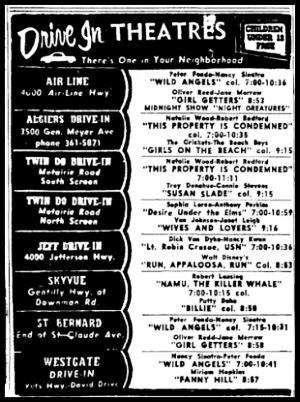
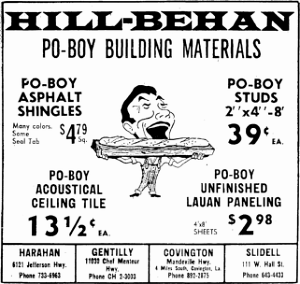 In 2001, after 89 years in business, Hill-Behan Lumber Company shut down its last 11 stores and closed due to "changing
ecomomics in our business". Organized in 1912 by Archibald M. Hill and William L. Behan in St. Louis, it grew to
become a prominent retailer of lumber and building materials with locations in four states -- Missouri, Illinois, Mississippi,
and Louisiana. It remained in the Behan family until the end.
In 2001, after 89 years in business, Hill-Behan Lumber Company shut down its last 11 stores and closed due to "changing
ecomomics in our business". Organized in 1912 by Archibald M. Hill and William L. Behan in St. Louis, it grew to
become a prominent retailer of lumber and building materials with locations in four states -- Missouri, Illinois, Mississippi,
and Louisiana. It remained in the Behan family until the end. 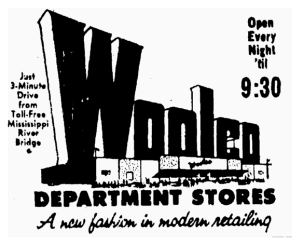
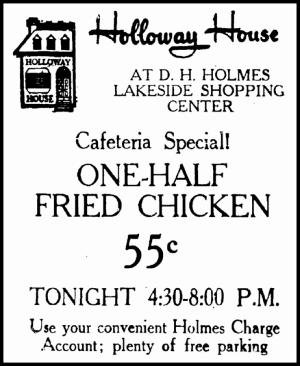 Advertisement of the D.H. Holmes department store's Holloway House at Lakeside Shopping Center in the September
3, 1966 edition of the Times-Picayune.
Advertisement of the D.H. Holmes department store's Holloway House at Lakeside Shopping Center in the September
3, 1966 edition of the Times-Picayune.